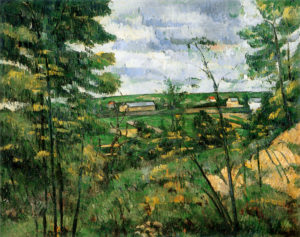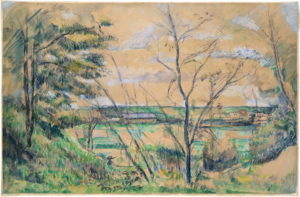R434 – La Plaine de Saint-Ouen-l’Aumône vue des carrières du Chou vers 1882 (FWN147)
Pavel Machotka
(Cliquer sur l’image pour l’agrandir)
In La Plaine de Saint-Ouen-l’Aumône vue des carrières du Chou the common purpose is harder to see at first, so repetitive and even nervous does the touch seem, but each stroke is in fact carefully considered there as well. Since we have evidence that the houses and trees were exactly where Cézanne had painted them – a more literal sketch of the same motif exists in gouache, which shows them (RW088) – we can see the site offering a clear invitation: the roofs, the fields, the trees on the right, all push toward the left, to be stopped by the vertical trees at the left edge, inviting a painter such as Cézanne to make the most of their opposition. To emphasize the opposition, Cézanne uses the parallel touch. On the right, in the sandy area, he uses a diagonal touch to strengthen the leftward push, and incidentally calls our attention to the otherwise insignificant diagonal sapling by making it border the sandy area; and on the left, in the trees, he uses vertical touches, almost relentlessly, to provide the firmest possible resistance. In this way the pushes and the resistances are made all the more clear, and, rather than being felt only as a tension across space, as in the gouache sketch, have become inherent to the weave of the fabric.
Adapted from Pavel Machotka, Cézanne: The Eye and the Mind.



